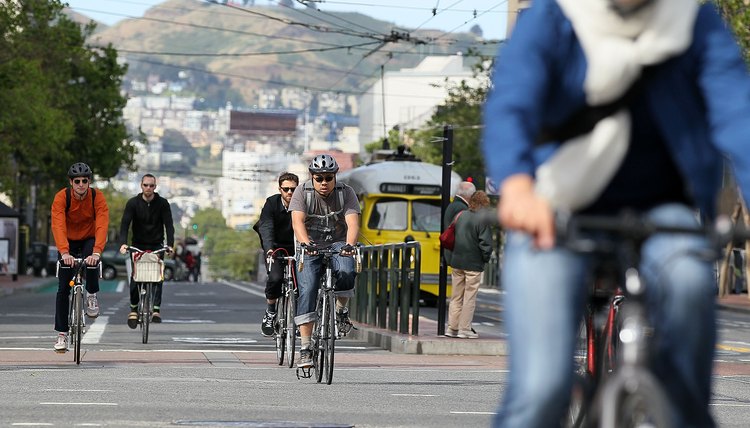Recommended Gear Ratio for My City Bike

The best single-speed bike for your urban commute should match the city you're in. Since every city presents its own challenges for cyclists, different gear ratios will help you tackle everything from the hilly suburbs of Los Angeles to the flat streets of Chicago. The best gear ratios for city bikes should give you the most efficiency during your commute.
Geared Up
Sheldon Brown, a veteran mechanic for Harris Cyclery, recommends basing the ideal gear ratio for your bike off a host of factors. Your best gearing setup for your bike depends on your weight, strength, endurance and riding habits, like frequent stops. For stronger riders, having a higher gear ratio lets you use more power to use more speed. Riders who don't want to works as hard can take advantage of a lower gear ratio to make pedaling easier, especially at low speeds. The steepness of your commute and the types of road surfaces will also impact the best ratio for your bike, since a hilly commute demands a lower gear ratio for conquering tough inclines.
The Generalist
For most riders, the best gear ratio is a 2:1 ratio. This means there are twice as many teeth on the chainring as there are on the rear cog. A bicycle with 32 teeth in the front and 16 in the back has a 2:1 ratio, and will perform for a wide range of riding conditions, like slight inclines and stop-and-go traffic. If your city has a wide mix of conditions, this is a good ratio to rely on. More powerful riders can increase their gear size to engage the chain with more teeth while preserving the ratio of gears; an 18/36 setup still has a ratio of 2:1.
Built for Speed
For city commuters who don't need to tackle hills, a single-speed with a higher gear ratio is ideal. A bike with 700c wheels that lives in a relatively flat city like New York City or anywhere in the midwest should set up with a gear ratio above 2:1. Bikes with gear ratios around 2.3:1 will slow your cadence at higher speeds, giving you more power. These bikes will be harder to pedal at low speed, so if your commute includes several stops, this won't be ideal. In cities with a good bike infrastructure, a 2.3:1 ratio can really let you open up for a quick, lively commute.
Climbing Steady
For hilly cities like San Francisco or Seattle, a bike with a lower gear ratio, like 1.7:1, will give you a little boost in your climbing ability. The lower gear ratio will significantly increase your cadence, letting you negotiate steeper inclines without needing a significant increase in power. A lower gear ratio is also ideal for commuters who prefer a slower pace, since it'll be easier to pedal at lower speeds.
References
Writer Bio
Max Roman Dilthey is a science, health and culture writer currently pursuing a master's of sustainability science. Based in Massachusetts, he blogs about cycling at MaxTheCyclist.com.
